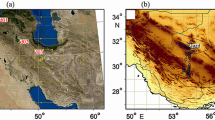Summary
A one-dimensional kinematic model is used to investigate the effects of silver iodide seeding in the region of a Cb cloud between isotherms of −8°C and −12°C. The agent interaction with cloud atmosphere is simulated by an improved microphysical model version which includes phoretic processes. The behaviour of the different agent types is investigated using the maximum values of agent mixing ratios and corresponding agent particle masses and radii.
It is shown that the agent residence time in the seeding zone significantly depends on vertical velocity. The residence time is comparable to that previously reported. On the other side, the final graupel production decreases slightly when vertical velocity increases, while the corresponding graupel production is quite different for agents used. The main agent nucleation mechanisms are the Brownian coagulation of cloud droplets, inertial impact of cloud droplets and deposition nucleation.
Similar content being viewed by others
References
Alkezweeny, A. J., 1971: A contact nucleation model for seeded clouds.J. Appl. Meteor.,10, 732–738.
Baker, B. A., 1991: On the role of phoresis in cloud ice initiation.J. Atmos. Sci.,48, 1545–1548.
Cooper, W. A., 1974: A possible mechanism for contact nucleation.J. Atmos. Sci.,31, 1832–1837.
Cotton, W. R., Stephens, M. A., Nehrkorn, T., Tripoli, G. J., 1982: The Colorado State University three-dimensional cloud/mesoscale model-1982. Part II: An ice phase parameterization.J. Rech. Atmos.,16, 295–320.
Cotton, W. R., Tripoli, G. J., Rauber, R. M., Mulvhill, E. A., 1986: Numerical simulation of the effects of varying ice crystal nucleation rates and aggregation processes on orographic snowfall.J. Climate Appl. Meteor.,114, 718–733.
Ćurić, M., Janc, D., 1990: Numerical study of the cloud seeding effects.Meteorol. Atmos. Phys. 42, 145–164.
Federer, B., Waldvogel, A., 1975: Hail and raindrop size distributions from a Swiss multicell storm.J. Appl. Meteor.,14, 91–97.
Fukuta, N., 1980:Advances in Cloud Physics. (Textbook). University of Utah, 220 pp.
Hsie, E.-Y., Farley, R. D., Orville, H. D., 1980: Numerical simulation of ice-phase convective cloud seeding.J. Appl. Meteor.,19, 950–977.
Huter, M., Prelesnik, B., Ćurić, M., Mitić D., Herak, R., 1988: X-ray diffraction analysis of aerosols obtained by burning of the AgI based pyrotechnics. In: Wagner, P. E., Vali, G. (eds.),Atmospheric Aerosols and Nucleation. Berlin, Heidelberg: Springer, pp. 670–673 (Lecture Notes in Physics, 309).
Kopp, F. J., 1988: A simulation of Alberta cumulus.J. Appl. Meteor.,27, 626–641.
Lin, Y.-L., Farley, R. D., Orville, H. D., 1983: Bulk parameterization of the snow field in a cloud model.J. Climate Appl. Meteor.,22, 1065–1092.
Mesinger, F., Mesinger, N., 1993: Has hail suppression in Eastern Yugoslavia led to a reduction in the frequency of hail?J. Appl. Meteor. (in press).
Orville, H. D., Chen, J.-M., 1982: Effects of cloud seeding, latent heat of fusion, and condensate loading on cloud dynamics and precipitation evolution: A numerical study.J. Atmos. Sci. 39, 2807–2827.
Orville, H. D., Farley, R. D., Hirsch, J. H., 1984: Some surprising results from simulated seeding of stratiform-type clouds.J. Climate Appl. Meteor.,12, 517–521.
Parungo, F. P., 1973: Electron-microscopic study of silver iodide as contact or sublimation nuclei.J. Appl. Meteor.,12, 517–521.
Radinović, Dj., 1989: Effectiveness of hail control in Serbia.J. Wea. Mod.,21, 75–84.
Slinn, W. G. N., 1971: Time constants for cloud seeding and tracer experiments.J. Atmos. Sci. 27, 299–307.
Srivastava, R. C., 1967: A study of the effect of precipitation on cumulus dynamics.J. Atmos. Sci.,24, 36–45.
Sulackvelidze, G. K., 1967:Showers and Hail. (In Russian). Leningrad: Gidrometizdat, 412 pp.
Young, K. C., 1974a: The role of contact nucleation in icephase initiation in clouds.J. Atmos. Sci.,31, 768–776.
Young, K. C., 1974b: A numerical simulation of wintertime, orographic precipitation: Part I: Description of model microphysics and numerical techniques.J. Atmos. Sci.,31, 1735–1748.
Young, K. C., 1974c: A numerical simulation of wintertime, orographic precipitation: Part II: Comparison of natural and AgI-seeded conditions.J. Atmos. Sci.,31, 1749–1767.
Author information
Authors and Affiliations
Additional information
With 9 Figures
Rights and permissions
About this article
Cite this article
Ćurić, M., Janc, D. Dependence of the simulated seeding effects of Cb cloud on the types of the AgI agents. Meteorl. Atmos. Phys. 52, 91–100 (1993). https://doi.org/10.1007/BF01025755
Received:
Revised:
Issue Date:
DOI: https://doi.org/10.1007/BF01025755



